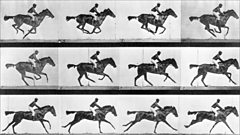Capturing Time
Sir Ian Blatchford and Dr Tilly Blyth on instantaneous images of photographer Eadweard Muybridge and physiologist Etienne Jules Marey. What kind of truths were being caught?
Sir Ian Blatchford and Dr Tilly Blyth continue their series exploring how art and science have inspired each other. They focus on photographic innovators of the late 1800s who used new advances in camera techniques to freeze time in the name of science, reanimate in the name of entertainment and seek new truths to human and animal motion.
At the National Science and Media Museum in Bradford, Tilly examines part of the Science Museum Group’s extensive collection of photographs by photojournalist and arch showman Eadweard Muybridge. His ingenious photo sequences of stills of a horse in motion helped settle a bet over whether the animal’s hooves leave the ground at speed. He would go on to devise magic lanterns with counter rotating discs of his artistically modified picture sequences to recreate the effect of movement, to the awe and excitement of viewers across America and Europe.
Muybridge had little regard for scientific rigour but whilst on tour in Paris his methods were enough to intrigue scientists such as physiologist Etienne Jules Marey who, as Ian illustrates, devised a chronophotographic camera to achieve multiple exposures of athletes in one single plate.
Instantaneous movement had been finally captured for accurate scientific analysis and for art and entertainment.
Producer Adrian Washbourne
Produced in partnership with The Science Museum Group
Photograph by SSPL/Getty Images
Last on
More episodes
Previous
Next
Clip
-
![]()
Capturing a horse in motion
Duration: 01:22
Broadcasts
- Thu 3 Oct 2019 13:45����ý Radio 4
- Thu 10 Jun 2021 19:45����ý Radio 4



